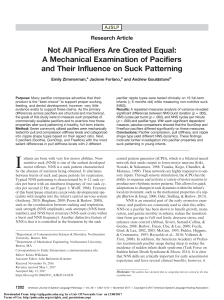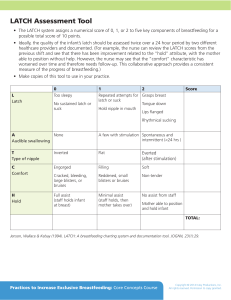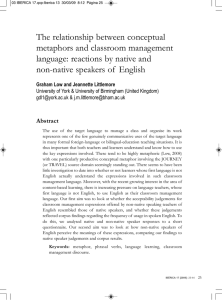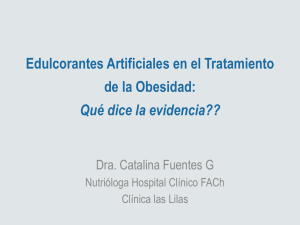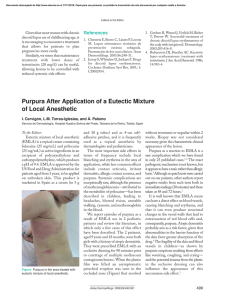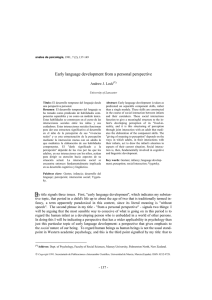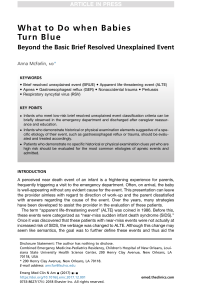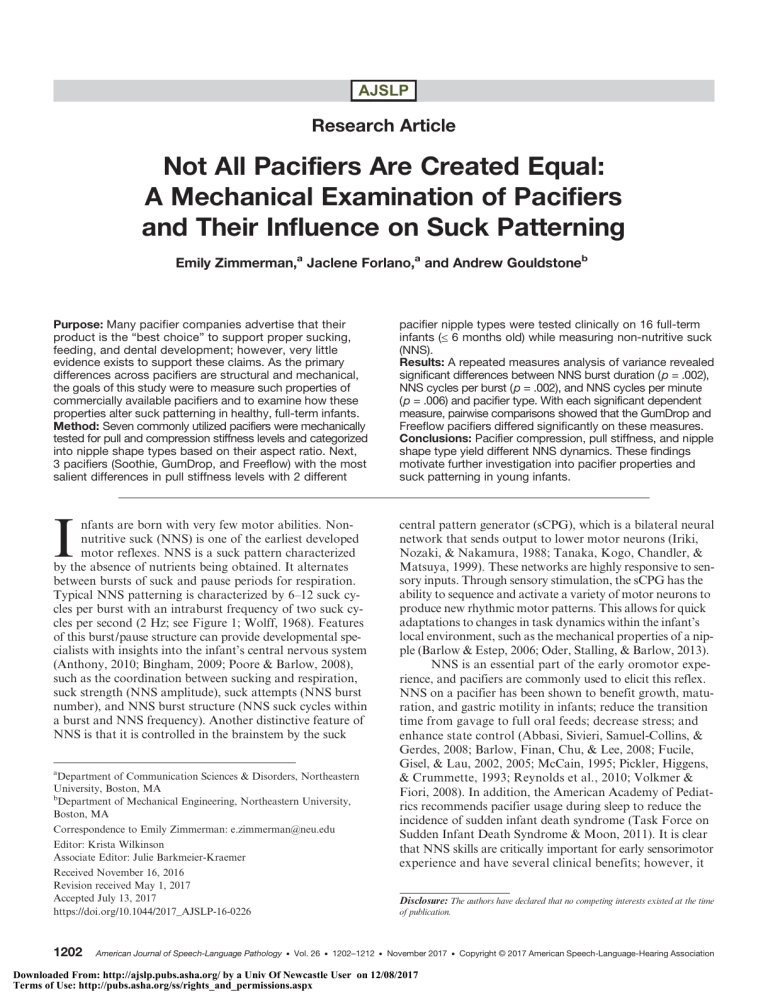
AJSLP Research Article Not All Pacifiers Are Created Equal: A Mechanical Examination of Pacifiers and Their Influence on Suck Patterning Emily Zimmerman,a Jaclene Forlano,a and Andrew Gouldstoneb Purpose: Many pacifier companies advertise that their product is the “best choice” to support proper sucking, feeding, and dental development; however, very little evidence exists to support these claims. As the primary differences across pacifiers are structural and mechanical, the goals of this study were to measure such properties of commercially available pacifiers and to examine how these properties alter suck patterning in healthy, full-term infants. Method: Seven commonly utilized pacifiers were mechanically tested for pull and compression stiffness levels and categorized into nipple shape types based on their aspect ratio. Next, 3 pacifiers (Soothie, GumDrop, and Freeflow) with the most salient differences in pull stiffness levels with 2 different pacifier nipple types were tested clinically on 16 full-term infants (≤ 6 months old) while measuring non-nutritive suck (NNS). Results: A repeated measures analysis of variance revealed significant differences between NNS burst duration (p = .002), NNS cycles per burst (p = .002), and NNS cycles per minute (p = .006) and pacifier type. With each significant dependent measure, pairwise comparisons showed that the GumDrop and Freeflow pacifiers differed significantly on these measures. Conclusions: Pacifier compression, pull stiffness, and nipple shape type yield different NNS dynamics. These findings motivate further investigation into pacifier properties and suck patterning in young infants. I central pattern generator (sCPG), which is a bilateral neural network that sends output to lower motor neurons (Iriki, Nozaki, & Nakamura, 1988; Tanaka, Kogo, Chandler, & Matsuya, 1999). These networks are highly responsive to sensory inputs. Through sensory stimulation, the sCPG has the ability to sequence and activate a variety of motor neurons to produce new rhythmic motor patterns. This allows for quick adaptations to changes in task dynamics within the infant’s local environment, such as the mechanical properties of a nipple (Barlow & Estep, 2006; Oder, Stalling, & Barlow, 2013). NNS is an essential part of the early oromotor experience, and pacifiers are commonly used to elicit this reflex. NNS on a pacifier has been shown to benefit growth, maturation, and gastric motility in infants; reduce the transition time from gavage to full oral feeds; decrease stress; and enhance state control (Abbasi, Sivieri, Samuel-Collins, & Gerdes, 2008; Barlow, Finan, Chu, & Lee, 2008; Fucile, Gisel, & Lau, 2002, 2005; McCain, 1995; Pickler, Higgens, & Crummette, 1993; Reynolds et al., 2010; Volkmer & Fiori, 2008). In addition, the American Academy of Pediatrics recommends pacifier usage during sleep to reduce the incidence of sudden infant death syndrome (Task Force on Sudden Infant Death Syndrome & Moon, 2011). It is clear that NNS skills are critically important for early sensorimotor experience and have several clinical benefits; however, it nfants are born with very few motor abilities. Nonnutritive suck (NNS) is one of the earliest developed motor reflexes. NNS is a suck pattern characterized by the absence of nutrients being obtained. It alternates between bursts of suck and pause periods for respiration. Typical NNS patterning is characterized by 6–12 suck cycles per burst with an intraburst frequency of two suck cycles per second (2 Hz; see Figure 1; Wolff, 1968). Features of this burst/pause structure can provide developmental specialists with insights into the infant’s central nervous system (Anthony, 2010; Bingham, 2009; Poore & Barlow, 2008), such as the coordination between sucking and respiration, suck strength (NNS amplitude), suck attempts (NNS burst number), and NNS burst structure (NNS suck cycles within a burst and NNS frequency). Another distinctive feature of NNS is that it is controlled in the brainstem by the suck a Department of Communication Sciences & Disorders, Northeastern University, Boston, MA b Department of Mechanical Engineering, Northeastern University, Boston, MA Correspondence to Emily Zimmerman: [email protected] Editor: Krista Wilkinson Associate Editor: Julie Barkmeier-Kraemer Received November 16, 2016 Revision received May 1, 2017 Accepted July 13, 2017 https://doi.org/10.1044/2017_AJSLP-16-0226 1202 Disclosure: The authors have declared that no competing interests existed at the time of publication. American Journal of Speech-Language Pathology • Vol. 26 • 1202–1212 • November 2017 • Copyright © 2017 American Speech-Language-Hearing Association Downloaded From: http://ajslp.pubs.asha.org/ by a Univ Of Newcastle User on 12/08/2017 Terms of Use: http://pubs.asha.org/ss/rights_and_permissions.aspx Figure 1. In this 30-s suck trace, the infant produced two non-nutritive suck (NNS) bursts with 10 cycles (black box) in Burst 1 and 12 cycles in Burst 2 using the Soothie pacifier. NNS amplitude is measured in centimeters of water (cmH2O) and is denoted by measuring the peak of the cycle. is often difficult for speech-language pathologists (SLPs) and other developmental therapists to know which pacifier to select to encourage NNS. Pacifier brands often advertise their product as the “best choice” to support sucking, feeding, and dental development. Yet, very little evidence exists from the manufacturers to support these claims. This is concerning because oromotor experiences (chewing and sucking) have been shown to greatly alter the development of oral anatomy (Ikeda, 1998; Liu, Ikeda, Harada, Kasahara, & Ito, 1998). For example, various sucking and feeding practices across cohorts and cultures result in differences in oral anatomy, such as posterior cross-bite, narrow upper jaws, labial segmental alignment, and anterior open bite (Agurto, Diaz, Cadiz, & Borenrieth, 1999; Duncan, McNamara, Ireland, & Sandy, 2008; Larsson, 1998; Lindner & Modeer, 1989). Beyond sucking and chewing experiences, pacifier properties themselves are capable of altering NNS (Oder et al., 2013; Zimmerman & Barlow, 2008). Zimmerman and Barlow examined the pacifier compression (squeeze) stiffness levels of three types of commercially available pacifiers (Wee Soothie, Soothie, and Super Soothie) manufactured by the same company (Philips Avent; Zimmerman & Barlow, 2008). The authors found that the Super Soothie nipple is seven times stiffer than the Wee or Soothie pacifiers, although shape and displaced volume are identical. Next, the Soothie and Super Soothie pacifiers were tested clinically among 20 preterm infants during their 3-month neonatal intensive care unit follow-up. Testing revealed significant differences in NNS cycles per minute, NNS amplitude, NNS cycles per burst, and NNS cycle periods as a function of pacifier stiffness. This study revealed a nonpreference to suck on the Super Soothie pacifier due to its high stiffness levels. Oder and colleagues examined the effect of morphological features across nine different textured pacifiers on NNS in 28 healthy term infants. Textures were created using the regular Soothie geometry as the template and varied in spatial array density (1-, 3-, and 5-mm spacing) and location (nipple cylinder, pacifier base, or the pacifier bulb; Oder et al., 2013). While using the smoothest pacifier, infants significantly increased their total compressions, NNS cycles, NNS cycles per burst, NNS compression pressure amplitudes, and NNS cycles as a percentage of total nipple compressions. These findings suggest that the regular Soothie pacifier is preferred over the novel textured pacifiers. Together, these studies reveal the potent effect that the local oral sensory environment can have on modulating suck output. Given the high sensitivity of the sCPG to environmental influences, a more thorough investigation into pacifier properties is warranted. Bottle and nipple properties have been examined extensively. In-depth testing on nipple flow rates revealed considerable variability across manufacturers (Jackman, 2013; Mathew, 1988; Pados, Park, Thoyre, Estrem, & Nix, 2016). Results from these studies have yielded clinically relevant guidelines for helping SLPs select bottle nipples for hospitalized infants and infants discharged from the hospital. Often, SLPs select bottle and nipple combinations, in most cases, for infants demonstrating oromotor difficulties, and choosing which bottle/nipple combination to use should be matched to the infant’s skill set. These comprehensive tests and clinical guidelines are missing for pacifiers, and there are no data available to support which pacifier is used and why. No study to date has explored the structural properties of pacifiers across a wide commercial range and compared specific aspects of those properties and related these to NNS. Therefore, this study had the following aims: (a) to quantitatively examine commonly used and commercially available pacifiers based on their nipple shape, nipple compression stiffness, and nipple pull stiffness and (b) to subsequently test a subgroup of these pacifier characteristics clinically in a cohort of full-term infants and examine their effect on suck patterning (NNS amplitude, NNS cycles per burst, NNS burst, NNS burst duration, NNS cycles, and NNS frequency). It was hypothesized that increased pacifier pull stiffness and pacifier nipple type would significantly alter suck patterning. Experiment 1: Mechanical Pacifier Testing Materials and Method Figure 2 shows seven commercially available pacifiers, arranged by shape type. Shape type was determined by calculating the pacifier ratio, defined as: Ratio ¼ Tip Vertical D Tip Horizontal D (1Þ In the ratio equation above, the tip is defined as the compliant portion of the pacifier and D is defined as the largest dimension in either the horizontal or vertical direction. Pacifiers were grouped into a single shape type if their ratios were similar within 20%. This yielded three subtypes (A–C). Pacifier type and shape were measured and agreed upon by five student researchers. Next, the pacifiers were measured for their compression and pull stiffness levels (see Figure 3). This involved a custom-built mechanical tester designed to (a) controllably Zimmerman et al.: The Influence of Pacifiers on Suck Patterning Downloaded From: http://ajslp.pubs.asha.org/ by a Univ Of Newcastle User on 12/08/2017 Terms of Use: http://pubs.asha.org/ss/rights_and_permissions.aspx 1203 Figure 2. To find the pacifier nipple ratio, the horizontal and vertical dimensions were measured. Then, this ratio was used to categorize the pacifier nipples into Types A–C. pull (or push) on pacifier tips and (b) continuously measure the force required to do so. For pulling (or pushing), a linear actuator (Zaber Technologies LSR150B; see Figure 3A) allowing a maximum displacement motion of 150 mm Figure 3. (A) Picture of the mechanical test setup (linear actuator labeled). (B) Soothie pacifier undergoing compression testing (transducer labeled). (C) Soothie pacifier undergoing pull tensile testing. (D) The compression and pull stiffness levels, pacifier nipple types, and pacifier base shape of the three pacifiers that were tested clinically. and an accuracy of 0.015 mm was used. To measure force, a transducer (Grass Technologies Load Cell FT03 E; see Figure 3B) was used on its lightest setting with a maximum allowable range of 30 N (3 kg) and an accuracy of 1 mN (0.10 g). This setting was chosen due to the softness of the pacifier tips used in the study. To measure the compression stiffness (see Figure 3B), a probe comparable to the size of the pacifier nipple was fixed to the transducer. The pacifier was constrained to avoid excess movement, with the nipple resting on a hard, flat surface. The probe was advanced in 0.2-mm increments to a maximum depth of 3 mm, and the force to compress the tip was continuously recorded. To measure the pull stiffness (see Figure 3C), a similar procedure pulled the pacifier using a pair of “soft-jawed” clamps. The grips were designed so that each pacifier’s gage length (length of the pacifier material actually being pulled) was consistent between experiments. These compression and pull tests were repeated with two samples of each of the seven standard, commercially available pacifiers, and a new pacifier was used for each experiment. To quantify stiffness, raw data (force [newtons] vs. displacement [millimeters]) were fit to a linear slope, with resulting units of newtons per millimeter. Results An analysis of variance (ANOVA) revealed there to be significant ( p < .001) differences in compression stiffness based on pacifier type (see Table 1). Multiple comparisons, 1204 American Journal of Speech-Language Pathology • Vol. 26 • 1202–1212 • November 2017 Downloaded From: http://ajslp.pubs.asha.org/ by a Univ Of Newcastle User on 12/08/2017 Terms of Use: http://pubs.asha.org/ss/rights_and_permissions.aspx Table 1. The multiple comparisons, with a Bonferroni post hoc adjustment, for pacifier compression. Pacifier types Super Soothie Nuk Playtex MAM GumDrop Freeflow Soothie Nuk Playtex MAM GumDrop Freeflow Soothie Super Soothie Playtex MAM GumDrop Freeflow Soothie Super Soothie Nuk MAM GumDrop Freeflow Soothie Super Soothie Nuk Playtex GumDrop Freeflow Soothie Super Soothie Nuk Playtex MAM Freeflow Soothie Super Soothie Nuk Playtex GumDrop Freeflow Soothie Super Soothie Playtex Nuk Playtex MAM Freeflow 95% Confidence interval Mean difference Std. error Sig. Lower bound Upper bound 0.52472* 0.57045* 0.58452* 0.66414* 0.66805* 0.68424* −0.52472* 0.04573 0.05979 0.13942* 0.14333* 0.15952* −0.57045* −0.04573 0.01407 0.09369 0.09761 0.11380 −0.58452* −0.05979 −0.01407 0.07962 0.08354 0.09973 −0.66414* −0.13942* −0.09369 −0.07962 0.00392 0.02011 −0.66805* −0.14333* −0.09761 −0.08354 −0.00392 0.01619 −0.68424* −0.15952* −0.11380 −0.09973 −0.02011 −0.01619 0.02655 0.02655 0.02655 0.02655 0.02655 0.02655 0.02655 0.02655 0.02655 0.02655 0.02655 0.02655 0.02655 0.02655 0.02655 0.02655 0.02655 0.02655 0.02655 0.02655 0.02655 0.02655 0.02655 0.02655 0.02655 0.02655 0.02655 0.02655 0.02655 0.02655 0.02655 0.02655 0.02655 0.02655 0.02655 0.02655 0.02655 0.02655 0.02655 0.02655 0.02655 0.02655 .000 .000 .000 .000 .000 .000 .000 1.000 1.000 .025 .021 .011 .000 1.000 1.000 .202 .166 .076 .000 1.000 1.000 .420 .341 .149 .000 .025 .202 .420 1.000 1.000 .000 .021 .166 .341 1.000 1.000 .000 .011 .076 .149 1.000 1.000 0.4016 0.4474 0.4614 0.5410 0.5450 0.5611 −0.6478 −0.0774 −0.0633 0.0163 0.0202 0.0364 −0.6935 −0.1688 −0.1090 −0.0294 −0.0255 −0.0093 −0.7076 −0.1829 −0.1372 −0.0435 −0.0396 −0.0234 −0.7872 −0.2625 −0.2168 −0.2027 −0.1192 −0.1030 −0.7911 −0.2664 −0.2207 −0.2066 −0.1270 −0.1069 −0.8073 −0.2826 −0.2369 −0.2228 −0.1432 −0.1393 0.6478 0.6935 0.7076 0.7872 0.7911 0.8073 −0.4016 0.1688 0.1829 0.2625 0.2664 0.2826 −0.4474 0.0774 0.1372 0.2168 0.2207 0.2369 −0.4614 0.0633 0.1090 0.2027 0.2066 0.2228 −0.5410 −0.0163 0.0294 0.0435 0.1270 0.1432 −0.5450 −0.0202 0.0255 0.0396 0.1192 0.1393 −0.5611 −0.0364 0.0093 0.0234 0.1030 0.1069 *The mean difference is significant at the .05 level. with a Bonferroni post hoc adjustment, revealed the Super Soothie pacifier to be significantly ( p < .001) stiffer than the Nuk, Playtex, MAM, GumDrop, Freeflow, and Soothie pacifiers. The Nuk pacifier was significantly stiffer than the GumDrop (p = .025), Freeflow (p = .021), and Soothie ( p = .011) pacifiers. All comparisons that were not discussed are not significant. Similarly, an ANOVA revealed there to be a significant ( p < .001) difference in pacifier pull stiffness based on pacifier type (see Table 2). Multiple comparisons, with a Bonferroni post hoc adjustment, revealed the Super Soothie pacifier to be significantly ( p < .001) stiffer than the Nuk, Playtex, MAM, GumDrop, Freeflow, and Soothie pacifiers. Interestingly, the Freeflow pacifier was significantly stiffer than the Nuk (p < .003), Playtex (p < .005), MAM (p < .001), GumDrop (p < .017), and Soothie (p < .001) pacifiers. Also note that the pull stiffness was far greater than the compression stiffness. This is unsurprising, because an elastic, thinwalled, hollow cylinder is typically easier to “squeeze” than “stretch.” Given the resulting structural data, the clinical study proceeded with the Soothie, GumDrop, and Freeflow pacifiers. These three pacifiers provided the opportunity to determine the effect of differences in pull stiffness and shape independently, where compression stiffness remained relatively constant (see Figure 3D). Previous literature has explored rather wide ranges of compression stiffness levels (Zimmerman & Barlow, 2008) and textures (Oder et al., Zimmerman et al.: The Influence of Pacifiers on Suck Patterning Downloaded From: http://ajslp.pubs.asha.org/ by a Univ Of Newcastle User on 12/08/2017 Terms of Use: http://pubs.asha.org/ss/rights_and_permissions.aspx 1205 Table 2. The multiple comparisons, with a Bonferroni post hoc adjustment, for pacifier pull. Pacifier types Super Soothie Nuk Playtex MAM GumDrop Freeflow Soothie Nuk Playtex MAM GumDrop Freeflow Soothie Super Soothie Playtex MAM GumDrop Freeflow Soothie Super Soothie Nuk MAM GumDrop Freeflow Soothie Super Soothie Nuk Playtex GumDrop Freeflow Soothie Super Soothie Nuk Playtex MAM Freeflow Soothie Super Soothie Nuk Playtex MAM GumDrop Soothie Super Soothie Nuk Playtex MAM GumDrop Freeflow 95% Confidence interval Mean difference Std. error Sig. Lower bound Upper bound 3.00565* 2.94435* 3.38400* 2.75170* 1.91035* 3.29975* −3.00565* −0.06130 0.37835 −0.25395 −1.09530* 0.29410 −2.94435* 0.6130 0.43965 −0.19265 −1.03400* 0.35540 −3.38400* −0.37835 −0.43965 −0.63230 −1.47365* −0.08425 −2.75170* 0.25395 0.19265 0.63230 −0.84135* 0.54805 −1.91035* 1.09530* 1.03400* 1.47365* 0.84135* 1.38940* −3.29975* −0.29410 −0.35540 0.08425 −0.54805 −1.38940* 0.15001 0.15001 0.15001 0.15001 0.15001 0.15001 0. 15001 0.15001 0.15001 0.15001 0.15001 0.15001 0.15001 0.15001 0.15001 0.15001 0.15001 0.15001 0.15001 0.15001 0.15001 0.15001 0.15001 0.15001 0.15001 0.15001 0.15001 0.15001 0.15001 0.15001 0.15001 0.15001 0.15001 0.15001 0.15001 0.15001 0.15001 0.15001 0.15001 0.15001 0.15001 0.15001 .000 .000 .000 .000 .000 .000 .000 1.000 .833 1.000 .003 1.000 .000 1.000 .462 1.000 .005 1.000 .000 .833 .462 .083 .001 1.000 .000 1.000 1.000 .083 .017 .171 .000 .003 .005 .001 .017 .001 .000 1.000 1.000 1.000 .171 .001 2.3102 2.2489 2.6885 2.0562 1.2149 2.6043 −3.7011 −0.7568 −0.3171 −0.9494 −1.7908 −0.4014 −3.6398 −0.6342 −0.2558 −0.8881 −1.7295 −0.3401 −4.0795 −1.0738 −1.1351 −1.3278 −2.1691 −0.7797 −3.4472 −0.4415 −0.5028 −0.0632 −1.5368 −0.1474 −2.6058 0.3998 0.3385 0.7782 0.1459 0.6939 −3.9952 −0.9896 −1.0509 −0.6112 −1.2435 −2.0849 3.7011 3.6398 4.0795 3.4472 2.6058 3.9952 −2.3102 0.6342 1.0738 0.4415 −0.3998 0.9896 −2.2489 0.7568 1.1351 0.5028 −0.3385 1.0509 −2.6885 0.3171 0.2558 0.0632 −0.7782 0.6112 −2.0562 0.9494 0.8881 1.3278 −0.1459 1.2435 −1.2149 1.7908 1.7295 2.1691 1.5368 2.0849 −2.6043 0.4014 0.3401 0.7797 0.1474 −0.6939 *The mean difference is significant at the .05 level. 2013); therefore, the authors chose to work within a smaller mechanical range to see if even these subtle differences had meaningful clinical differences. Experiment 2: Clinical Pacifier Testing Materials and Method The effects of pacifier pull stiffness and pacifier nipple types were tested on 16 full-term (birth weight range = 5.60–11.20 lbs), healthy infants (12 boys and four girls), 6 months old and younger (age at testing: mean = 3.64 (±2.00) months, range = 1 month 4 days to 6 months 21 days), with no reported medical complications (see Table 3). The institutional review board approved the study, and parental 1206 consent was attained before the start of the study. Parking was paid for, and parents were compensated with a $20 gift card to Babies R Us. Parents/caregivers were recruited through the laboratory Facebook page, local “mom” websites, forums, blogs, discussion boards, and flyers posted across the local community. Parents brought their infants to the laboratory approximately 1 hr before their scheduled feeding. This time was purposely chosen to ensure that infants would be alert and ready to partake in NNS, as previous research has shown that neonatal reflexes, such as sucking, are tied to the infant’s ability to attain and maintain an alert state (Korner, 1972; Prechtl, 1974). When parents arrived at the laboratory, they completed an intake form that had the following questions: pregnancy information—Did you have any American Journal of Speech-Language Pathology • Vol. 26 • 1202–1212 • November 2017 Downloaded From: http://ajslp.pubs.asha.org/ by a Univ Of Newcastle User on 12/08/2017 Terms of Use: http://pubs.asha.org/ss/rights_and_permissions.aspx Table 3. Characteristics of the study participants. Subject Gender Birth weight (lbs) Study weight (lbs) Pacifier use Pacifier type Feed type M-01 M-02 M-03 M-04 M-05 M-06 M-07 M-08 M-09 M-10 M-11 M-12 M-13 M-14 M-15 M-16 Male Male Male Female Female Male Female Male Male Male Male Male Male Male Male Female 7.90 8.00 11.20 8.70 5.70 7.00 7.90 8.40 10.10 7.00 8.10 9.10 8.20 8.30 7.50 9.30 11.50 16.00 8.75 16.00 Unknown 16.00 9.00 17.00 17.00 Unknown 11.70 20.90 9.90 19.90 11.00 13.00 Yes Yes Yes Yes Yes Yes Yes Yes Yes Yes Yes Yes Yes No Yes Yes Nuk/Soothiea Soothiea Nuk Soothiea Nuk Soothiea Aventa Aventa Aventa Not reported Nuk Aventa Aventa None Soothiea MAM Breast Both Bottle Both Breast Breast Breast Breast Bottle Breast Both Bottle Bottle Breast Both Breast a Note that the Philips Avent pacifier is the manufacturer that makes the Soothie pacifier. Although parents reported that their infants used the Soothie or Avent, they were likely referring to the same pacifier. complications during pregnancy? Did you deliver vaginally or via cesarean section? At what week did you deliver?; infant information—Age? Sex? Birthdate? Current weight? Were there any complications during delivery? Did your infant require any care in the neonatal intensive care unit? Did your infant require any immediate assistance after birth (e.g., oxygen)? What was your infant’s birth weight? Typically, does your infant feed by bottle or by breast? Does your infant have any diagnosed health or feeding conditions? Does your infant attend to speech and nonspeech stimuli? Does your infant typically use a pacifier? If so, what brand/ type do you usually choose to buy for your infant? Most parents (93.75%) responded “yes” to infant pacifier usage on the intake form: 62.50% reported using the Soothie/Avent brand, 31.25% reported using the Nuk brand, and 6.35% did not report the brand of pacifier (see Table 3). After the intake form was completed, infants were fitted with a Pneumotrace respiratory belt transducer (ADInstruments) to measure respiratory rate and with Softrace small Radiolucent (RTL) electrodes (Conmed) to measure heart rate and heart rate variability. The cardiac signals were amplified using a Bio Amp (ADInstruments). The cardiorespiratory measures were control variables used throughout the study to ensure that cardiorespiratory patterning remained stable and consistent across pacifier types. Next, infants were offered three different pacifiers—the Soothie, GumDrop, and Freeflow—to suck on for 2 min each. The caregiver held the infant during the study to allow for a more natural sucking environment and to avoid researcher bias (e.g., the researcher inadvertently encouraging one pacifier over another). These pacifiers were connected to a pressure transducer, which detected and measured the infants’ NNS pattern. The system utilized a pressure transducer (Honeywell TruStability HSC Series Pressure Sensor) that was housed within the pacifier handle and measured the pressure within the pacifier during infant sucking. The pressure transducer was calibrated before each participant. The order of pacifier presentation was randomized and counterbalanced across subjects. Data acquisition was completed using the ADInstruments PowerLab (16/35) system, and Labchart Pro software was used to analyze cardiac, respiratory, and NNS dynamics. Suck dynamics included NNS burst duration (seconds), cycles per burst, cycles per minute, bursts per minute, frequency (hertz), and amplitude (centimeters of water). All data were saved as the participant’s ID number in an effort to avoid researcher bias during data analysis. Each infant was offered a new pacifier for the study, and all pacifiers were discarded after the study was completed. Results Data were attained on all of the participants, and there were no missing data. Separate repeated measures ANOVA were completed to examine the effect of pacifier type on the NNS dependent variables and the cardiorespiratory control variables (see Table 4). There were no statistically significant differences between pacifier type and the cardiorespiratory outcomes, indicating that the three different pacifiers did not have a significant effect on the infants’ cardiorespiratory activity. However, statistical differences were found between pacifier type and the following NNS variables: NNS burst duration (seconds), NNS cycles per burst, and NNS cycles per minute. NNS burst duration (see Table 4) was found to be significantly (p = .002) different for pacifier type. A pairwise comparison revealed that the Freeflow pacifier significantly ( p = .006, 95% CI [−1.988, −0.325]) increased the NNS burst duration compared with the GumDrop pacifier. The Freeflow pacifier produced an average NNS burst duration of 2.87 (±1.29) sec, whereas the GumDrop pacifier produced a reduced NNS burst duration of 1.72 (±0.39) sec. Zimmerman et al.: The Influence of Pacifiers on Suck Patterning Downloaded From: http://ajslp.pubs.asha.org/ by a Univ Of Newcastle User on 12/08/2017 Terms of Use: http://pubs.asha.org/ss/rights_and_permissions.aspx 1207 Table 4. Non-nutritive suck (NNS) dependent variables and cardiorespiratory control variables across pacifier types. Outcomes Soothie GumDrop Freeflow Repeated measures analysis of variance Pairwise comparisons NNS dependent variables NNS amplitude (cmH2O) NNS frequency (Hz) NNS burst duration (s) NNS bursts/min NNS cycles/burst NNS cycles/min 86.19 (±30.56) 28.93–134.54 2.16 (±0.35) 1.22–2.61 2.50 (±1.39) 0.91–5.37 4.12 (±2.68) 1.00–9.00 5.59 (±3.09) 2.00–11.75 28.09 (±25.58) 2.00–82.00 58.97 (±29.01) 21.72–117.59 2.28 (±0.36) 1.24–3.05 1.72 (±0.39) 1.05–2.38 3.34 (±2.42) 1.00–8.00 3.91 (±1.13) 2.50–5.68 15.09 (±13.52) 2.50–46.00 64.53 (±12.91) 52.80–90.89 144.34 (±16.49) 120.46–175.32 25.90 (±16.56) 4.62–53.95 68.52 (±19.86) 29.58–95.16 6.08 (±6.42) 0.55–21.24 60.91 (±12.30) 30.99–81.29 142.51 (±13.94) 119.27–167.80 21.95 (±8.89) 10.13–41.72 70.08 (±17.22) 34.28–89.47 5.43 (±3.92) 1.56–15.74 64.77 (±44.09) 4.16–152.76 2.31 (±0.34) 1.42–2.92 2.87 (±1.29) 1.03–6.22 4.00 (±1.99) 1.00–7.00 6.83 (±2.93) 2.00–13.25 31.34 (±22.97) 2.50–85.00 F(2, 30) = 2.955,a p = .093 F(2, 30) = 0.982, p = .386 F(2, 30) = 7.382, p = .002 F(2, 30) = 1.006, p = .378 F(2, 30) = 8.015, p = .002 F(2, 30) = 6.124, p = .006 GumDrop vs. Freeflow ( p = .006)b GumDrop vs. Freeflow ( p = .004)b GumDrop vs. Freeflow ( p = .021)b Cardiorespiratory control variables Respiratory rate (BPM) Heart rate (BPM) High-frequency heart rate variability (%) Low-frequency heart rate variability (%) Low-/high-frequency heart rate variability 64.65 (±15.45) 38.74–96.63 142.15 (±15.04) 120.16–164.40 23.40 (±13.08) 8.68–52.11 66.45 (±21.73) 35.58–91.26 4.96 (±3.58) 1.00–13.22 F(2, 30) = 0.990, p = .383 F(2, 30) = 0.373, p = .692 F(2, 30) = 0.470, p = .630 F(2, 30) = 0.197, p = .822 F(2, 30) = 0.282,a p = .689 Note. Numbers represent the mean (standard deviation) and range. Greenhouse–Geisser correction. bBonferroni post hoc adjustment. a Significant differences for pacifier type were also evident in NNS cycles per burst ( p = .002) and NNS cycles per minute ( p = .006; see Table 4). The Freeflow pacifier produced a mean of 6.83 (±2.93) cycles/burst, whereas the GumDrop pacifier produced only 3.91 (±1.13) cycles/burst ( p = .004, 95% CI [−4.904, −0.946]). The Freeflow pacifier allowed for an increased number of cycles per minute (31.34 [±22.97] cycles/min) as compared with the GumDrop pacifier (15.09 [±13.52] cycles/min), yielding a significant difference ( p = .021, 95% CI [2.233, 30.455]). Although not significant (p = .093), an emerging trend was evident in the dependent measure of NNS amplitude. The Soothie pacifier, the least stiff in pull stiffness levels (and compression, although less apparent), yielded higher NNS amplitudes (86.19 ± 30.56 cmH2O) compared with the GumDrop (58.97 ± 29.01 cmH2O) and Freeflow (64.77 ± 44.09 cmH2O) pacifiers. Discussion In this study, seven popular, commercially available pacifiers were mechanically tested for their compression and pull stiffness levels. In addition, each pacifier was categorized by its respective nipple shape ratio into types A–C and further described by its pacifier nipple and base shape (concave/flat). These tests revealed there to be a tremendous amount of variability in the stiffness levels 1208 and pacifier types that are offered on the commercial market, with little explanation as to why and essentially no explanation as to how these properties influence NNS. To answer some of these pertinent questions, three different pacifiers with similar compression stiffness levels were clinically tested to examine differences in pull stiffness, nipple type, and base shape. It is speculated that the significant increase in NNS dynamics (burst duration, cycles per burst, cycles per minute) evident in the Freeflow pacifier are due to its nipple shape (Type B, bulbed nipple) and that this attribute compensates for its higher stiffness level. This assertion is further supported by the observation that, between the identically shaped nipples of Soothie and GumDrop pacifiers, the stiffer GumDrop pacifier yielded a lower NNS output on all measures. The Freeflow nipple shape and concave base shape likely coupled best to the infant’s intraoral and perioral regions, thereby allowing for a tight latch resulting in the infant performing longer suck burst durations. It was noted that, during clinical testing, there was a gap between the infant’s face and the GumDrop pacifier’s (concave) base, which did not allow for an optimal seal. This was not evident in the Freeflow or Soothie pacifier. Although not quantified in this study, this appears to be a further indicator of reduced NNS. The results of this study support the hypothesis that pacifier mechanics and properties across manufacturers/ American Journal of Speech-Language Pathology • Vol. 26 • 1202–1212 • November 2017 Downloaded From: http://ajslp.pubs.asha.org/ by a Univ Of Newcastle User on 12/08/2017 Terms of Use: http://pubs.asha.org/ss/rights_and_permissions.aspx brands do, in fact, alter suck patterning in healthy, full-term infants. Of all the properties tested, pacifier shape played the most significant role in the NNS bursting characteristics, whereas pacifier stiffness level played a larger role in NNS amplitudes. Although not significant, the Soothie pacifier yielded the highest NNS amplitudes. These results are similar to those of a previous study completed by Zimmerman and Barlow (2008) who also found the Soothie pacifier to yield the highest NNS amplitudes. In both studies, the findings suggest that more compliant pacifiers allowed infants to suck more rigorously on them, thereby enhancing NNS amplitudes. It is speculated that the changes evident in modulating NNS amplitudes are highly governed by structural properties. SLPs and other developmental specialists use pacifiers to assess suck characteristics in young infants—particularly with infants who are exhibiting sucking or feeding difficulties (i.e., poor latch, oromotor difficulties, muscle weakness, lack of NNS experience). The rigorous mechanical and clinical testing performed in this study are important steps toward better understanding of how pacifier properties alter NNS. Put simply, this study revealed that different pacifier properties yielded different NNS outcomes. This type of sensory modulation has also been shown in the feeding literature where various bottle nipple flows do not significantly alter rate of milk transfer for the infant (preterm/full-term; Mathew, 1988; McGrattan et al., 2017; Scheel, Schanler, & Lau, 2005), suggesting that infants are able to adapt their sucking rate and pressures as needed (Colley & Creamer, 1958; Scheel et al., 2005; Schrank, Al-Sayed, Beahm, & Thach, 1998). In the current study, the various pacifier properties did not deter the infant from initiating NNS bursts (NNS bursts per minute were not significant across pacifier types); rather, the adaptability of the sCPG allowed them the flexibility to modulate their burst duration, cycles per burst, and cycles per minute in response to the specific properties present in each of the pacifiers utilized. This study was completed on healthy, full-term infants, and different outcomes may be found in cohorts with sucking difficulties, neurological impairments, and/or medical complications that may impair their sensory feedback to the sCPG and therefore their ability to modulate NNS. There are likely many factors that contribute to an infant’s NNS ability. Previous pacifier experience could determine suck preferences, yielding different NNS patterns. The vast majority (93.75%) of the caregivers in the study reported that their infants used a pacifier, and 62.50% reported that their infants used the same brand (Soothie/Avent) that was used in the study. Although knowledge of pacifier use/ type was collected, this information did not reveal strong pacifier preferences within these data. In fact, the one participant whose mother reported that he (Subject 14; see Figure 4 and Table 4) did not use a pacifier had rather robust NNS on all the measures. More in-depth information such as frequency of pacifier usage (how many times per day, for how long, across how many months) needs to be collected, as well as more specifics on the identified brand, such as the age range (newborn, 0–6 months, > 6 months), whether it is an orthodontic pacifier, or other feature categories that are available within these brands (within-brand variability). For example, the Avent brand sells Newborn, Soothie, Classic, and Freeflow—all of which have different shapes and properties. These within-brand variables need to be considered in more detail, as this could inform treatment/evaluation decisions. This information is important clinically in the situation when an infant may not have well-patterned NNS on the Soothie pacifier, and the SLP would like to try another pacifier that may better fit the child’s anatomical or sucking needs. Does he or she stay within the Avent brand and try the Classic and/or Freeflow next, or does the clinician try another brand altogether? These mechanical and clinical data would better inform clinical practice. Last, other factors could be the infant’s weight, gender, and age at testing—all of which should be explored further in future studies with a larger sample size. Although there were compelling group differences in these data, NNS is very complex and must be considered on an individualized basis. Examining each participant’s data on the three significant dependent measures (see Figure 4) further confirmed the suck differences evident between pacifiers as well as the variability present across subjects. For example, Subject 2 had consistently high NNS activity on all measures, whereas Subject 1 had less robust NNS patterning. Therefore, clinicians are encouraged to consider each infant on a case-by-case basis. Knowledge of pacifier properties, similar to the ones tested in this study, and NNS patterning are critically important for SLPs and other developmental specialists to consider when working with young infants. This is because the benefits of NNS are immense and include enhancing essential clinical outcomes such as growth, maturation, gastric motility, state control, and stress reduction (Abbasi et al., 2008; Barlow et al., 2008; Fucile et al., 2002, 2005; McCain, 1995; Pickler et al., 1993; Reynolds et al., 2010; Volkmer & Fiori, 2008). Likely, the most clinically relevant outcome of interest for SLPs is the relation between NNS and oral feeding. NNS has been shown to have the following influences over oral feeding: results in higher feeding performance scores (Pickler et al., 1993), reduces the transition time to full oral feeding (Fucile et al., 2002; Zhang et al., 2014), has a positive effect on the initiation and duration of the first nutritive suck (Pickler, Frankel, Walsh, & Thompson, 1996), results in infants who are ready for bottle feeds sooner (1.5 days sooner than infants who did not receive NNS; Sehgal, Prakash, Gupta, Mohan, & Anand, 1990), and results in infants who took their bottles faster (1.5 min/30 ml faster; Sehgal et al., 1990). NNS plus oral sensorimotor stimulation, via manual oral stimulation or pulsating oral stimulation with the NTrainer System (Innara Health), have been shown to significantly reduce the transition time from introduction to independent oral feeding (Poore, Zimmerman, Barlow, Wang, & Gu, 2008; Rocha, Moreira, Pimenta, Ramos, & Lucena, 2007; Zhang et al., 2014), enhance milk transfer rate (Zhang et al., 2014), and improve breastfeeding rates (Pimenta et al., 2008). NNS Zimmerman et al.: The Influence of Pacifiers on Suck Patterning Downloaded From: http://ajslp.pubs.asha.org/ by a Univ Of Newcastle User on 12/08/2017 Terms of Use: http://pubs.asha.org/ss/rights_and_permissions.aspx 1209 Figure 4. Individual data from the three significant dependent variables: (A) non-nutritive suck (NNS) burst duration, (B) NNS cycles per burst, and (C) NNS cycles per minute across pacifier types Soothie (dotted line), GumDrop (solid black line), and Freeflow (solid gray line). has also been combined with other sensory modalities beyond oral stimulation, like vestibular, vision, and auditory, to examine how these sensory inputs can alter suck (Chorna, Slaughter, Wang, Stark, & Maitre, 2014; MedoffCooper, Rankin, Li, Liu, & White-Traut, 2015; WhiteTraut et al., 2002; Zimmerman & Barlow, 2012; Zimmerman & Foran, 2017). In addition, a state-of-the-art review by Zimmerman and Thompson revealed that there is very little evidence to support the notion of “nipple confusion” (an infant’s difficulty with or preference for one feeding mechanism over another after exposure to artificial nipples) in regard to pacifier usage (Zimmerman & Thompson, 2015). Thus, it is clear that a pacifier is a simple, safe, and clinically effective tool. Limitations in the study included a small sample size, derived from infants less than 6 months old. Although there remains a large amount of variability in development in the age range included in the study, future studies should focus on a more narrow age window. Infants were recruited from the Northeast through flyers and online parent communities. This recruitment may not be fully representative of all parents/infants and therefore weakens the ability to generalize these data to all cohorts. Participants did not report the hourly/daily/monthly usage of these pacifiers or the specifics on the pacifier brands/types. Future studies 1210 should capture these data and examine additional pacifier properties across other commercially available pacifiers. Using this study’s methods, it would be interesting to investigate to what extent infants with no previous pacifier use alter their NNS activity across pacifiers. It is also important to consider the impact of wear on the characteristics of the pacifiers. For example, do the pacifier properties deteriorate over time, and if so, what is the clinical impact? This would help establish specific pacifier guidelines as to how long a pacifier should be used by infants. Last, more data on pacifier properties and their impact on NNS will allow for quality control over pacifiers. Manufacturing standards provide the standardization of pacifier properties that will allow informed decision making for selection that is individualized to the infant’s skill set. Conclusions The results of this study reveal a wide variety of pacifier nipple type, pull stiffness, and compression stiffness levels across manufacturers and within brands. Clinical testing revealed that pacifier compression, pull stiffness, and nipple shape type yield different NNS dynamics. Pacifiers are very important tools for SLPs to use when assessing/ treating an infant’s NNS patterning. Therefore, these findings American Journal of Speech-Language Pathology • Vol. 26 • 1202–1212 • November 2017 Downloaded From: http://ajslp.pubs.asha.org/ by a Univ Of Newcastle User on 12/08/2017 Terms of Use: http://pubs.asha.org/ss/rights_and_permissions.aspx further motivate investigation into pacifier properties and suck patterning among brands and clinical populations (e.g., sucking difficulties, neurological impairments, and/or medical complications). Acknowledgments We would like to thank the participants in the study as well as Nathan Streeter, BS, for completing the mechanical testing of the pacifiers. References Abbasi, S., Sivieri, E., Samuel-Collins, N., & Gerdes, J. S. (2008). Effect of non-nutritive sucking on gastric motility of preterm infants. Paper presented at the Pediatric Academic Society, Honolulu, Hawaii. Agurto, P., Diaz, R., Cadiz, O., & Borenrieth, F. (1999). Oral bad habits frequency and its association with dentomazilar abnormal development in children three to six years old in East Santiago. Scandinavian Journal of Dental Research, 70(6), 470–482. Anthony, M. Y. (2010). The value of the clinical examination revisited. Developmental Medicine and Child Neurology, 52(3), 231. Barlow, S. M., & Estep, M. (2006). Central pattern generation and the motor infrastructure for suck, respiration, and speech. Journal of Communication Disorders, 39(5), 366–380. Barlow, S. M., Finan, D. S., Chu, S., & Lee, J. (2008). Patterns for the premature brain: Synthetic orocutaneous stimulation entrains preterm infants with feeding difficulties to suck. Journal of Perinatology, 28, 541–548. Bingham, P. M. (2009). Deprivation and dysphagia in premature infants. Journal of Child Neurology, 24(6), 743–749. Chorna, O. D., Slaughter, J. C., Wang, L. L., Stark, A. R., & Maitre, N. L. (2014). A pacifier-activated music player with mother’s voice improves oral feeding in preterm infants. Pediatrics, 133(3), 462–468. Colley, J. R., & Creamer, B. (1958). Sucking and swallowing in infants. The British Medical Journal, 2(5093), 422–423. Duncan, K., McNamara, C., Ireland, A. J., & Sandy, J. R. (2008). Sucking habits in childhood and the effects on the primary dentition: Findings of the Avon Longitudinal Study of Pregnancy and Childhood. International Journal of Paediatric Dentistry, 18(3), 178–188. Fucile, S., Gisel, E., & Lau, C. (2002). Oral stimulation accelerates the transition from tube to oral feeding in preterm infants. Journal of Pediatrics, 141, 230–236. Fucile, S., Gisel, E., & Lau, C. (2005). Effect of an oral stimulation program on sucking skill maturation of preterm infants. Developmental Medicine and Child Neurology, 47, 158–162. Ikeda, K. (1998). Development of jaw muscles’ function in rats fed a kneaded diet. Orthodontic Waves, 57, 366–376. Iriki, A., Nozaki, S., & Nakamura, Y. (1988). Feeding behavior in mammals: Corticobulbar projection is reorganized during conversion from sucking to chewing. Developmental Brain Research, 44(2), 189–196. Jackman, K. T. (2013). Go with the flow: Choosing a feeding system for infants in the neonatal intensive care unit and beyond based on flow performance. Newborn and Infant Nursing Reviews, 13, 31–34. Korner, A. F. (1972). State as variable, as obstacle, as mediator of stimulation in infant research. Merrill-Palmer Quarterly of Behavior and Development, 18(2), 77–94. Larsson, E. (1998). Orthodontic aspects on feeding of young children: 1. A comparison between Swedish and Norwegian-Sami children. Swedish Dental Journal, 22(3), 117–121. Lindner, A., & Modeer, T. (1989). Relation between sucking habits and dental characteristics in preschool children with unilateral cross-bite. Scandinavian Journal of Dental Research, 97(3), 278–283. Liu, Z. J., Ikeda, K., Harada, S., Kasahara, Y., & Ito, G. (1998). Functional properties of jaw and tongue muscles in rats fed a liquid diet after being weaned. Journal of Dental Research, 77(2), 366–376. Mathew, O. P. (1988). Nipple units for newborn infants: A functional comparison. Pediatrics, 81(5), 688–691. McCain, G. C. (1995). Promotion of preterm infant nipple feeding with nonnutritive sucking. Journal of Pediatric Nursing, 10, 3–8. McGrattan, K. E., McFarland, D. H., Dean, J. C., Hill, E., White, D. R., & Martin-Harris, B. (2017). Effect of single-use, lasercut, slow-flow nipples on respiration and milk ingestion in preterm infants. American Journal of Speech-Language Pathology, 26, 832–839. Medoff-Cooper, B., Rankin, K., Li, Z. Y., Liu, L., & White-Traut, R. (2015). Multisensory intervention for preterm infants improves sucking organization. Advances in Neonatal Care, 15(2), 142–149. Oder, A. L., Stalling, D. L., & Barlow, S. M. (2013). Short-term effects of pacifier texture on NNS in neurotypical infants. International Journal of Pediatrics, 2013, 168459. https://doi. org/10.1155/2013/168459 Pados, B. F., Park, J., Thoyre, S. M., Estrem, H., & Nix, W. B. (2016). Milk flow rates from bottle nipples used after hospital discharge. The American Journal of Maternal Child Nursing, 41(4), 237–243. Pickler, R. H., Frankel, H. B., Walsh, K. M., & Thompson, N. M. (1996). Effects of nonnutritive sucking on behavioral organization and feeding performance in preterm infants. Nursing Research, 45(3), 132–135. Pickler, R. H., Higgens, K. E., & Crummette, B. D. (1993). The effect of nonnutritive sucking on bottle-feeding stress in preterm infants. Journal of Obstetric, Gynecologic, and Neonatal Nursing, 22(3), 230–234. Pimenta, H. P., Moreira, M. E., Rocha, A. D., Gomes, S. C., Jr., Pinto, L. W., & Lucena, S. L. (2008). Effects of non-nutritive sucking and oral stimulation on breastfeeding rates for preterm, low birth weight infants: A randomized clinical trial. Jornal de Pediatria, 84(5), 423–427. Poore, M., & Barlow, S. M. (2008). Suck predicts neuromotor integrity and developmental outcomes. SIG 5 Perspectives on Speech Science and Orofacial Disorders, 19, 44–51. Poore, M., Zimmerman, E., Barlow, S. M., Wang, J., & Gu, F. (2008). Patterned orocutaneous therapy improves sucking and oral feeding in preterm infants. Acta Paediatrica, 97(7), 920–927. Prechtl, H. F. (1974). The behavioural states of the newborn infant (a review). Brain Research, 76(2), 185–212. Reynolds, E., Grider, D., Caldwell, R., Capilouto, G., Patwardhan, A., & Charnigo, R. (2010). Variations in phase of respiration with swallow during nonnutritive suck in low-risk premies and infants with BPD. Paper presented at the Pediatric Academic Society, Vancouver, BC, Canada. Rocha, A. D., Moreira, M. E. L., Pimenta, H. P., Ramos, J. R. M., & Lucena, S. L. (2007). A randomized study of the efficacy of sensory-motor-oral stimulation and non-nutritive sucking in very low birthweight infant. Early Human Development, 83(6), 385–388. Zimmerman et al.: The Influence of Pacifiers on Suck Patterning Downloaded From: http://ajslp.pubs.asha.org/ by a Univ Of Newcastle User on 12/08/2017 Terms of Use: http://pubs.asha.org/ss/rights_and_permissions.aspx 1211 Scheel, C. E., Schanler, R. J., & Lau, C. (2005). Does the choice of bottle nipple affect the oral feeding performance of very-lowbirthweight (VLBW) infants? Acta Paediatrica, 94(9), 1266–1272. Schrank, W., Al-Sayed, L. E., Beahm, P. H., & Thach, B. T. (1998). Feeding responses to free-flow formula in term and preterm infants. Journal of Pediatrics, 132(3, Pt. 1), 426–430. Sehgal, S. K., Prakash, O., Gupta, A., Mohan, M., & Anand, N. K. (1990). Evaluation of beneficial effects of nonnutritive sucking in preterm infants. Indian Pediatrics, 27(3), 263–266. Tanaka, S., Kogo, M., Chandler, S. H., & Matsuya, T. (1999). Localization of oral–motor rhythmogenic circuits in the isolated rat brainstem preparation. Brain Research, 821(1), 190–199. Task Force on Sudden Infant Death Syndrome, & Moon, R. Y. (2011). SIDS and other sleep-related infant deaths: Expansion of recommendations for a safe infant sleeping environment. Pediatrics, 128(5), e1341–e1367. Volkmer, A. S., & Fiori, H. H. (2008). Non-nutritive sucking with a pacifier in preterm infants. Paper presented at the Pediatric Academic Society, Honolulu, Hawaii. White-Traut, R. C., Nelson, M. N., Silvestri, J. M., Vasan, U., Littau, S., Meleedy-Rey, P., . . . Patel, M. (2002). Effect of 1212 auditory, tactile, visual, and vestibular intervention on length of stay, alertness, and feeding progression in preterm infants. Developmental Medicine and Child Neurology, 44(2), 91–97. Wolff, P. H. (1968). The serial organization of sucking in the young infant. Pediatrics, 42, 943–956. Zhang, Y., Lyu, T., Hu, X., Shi, P., Cao, Y., & Latour, J. M. (2014). Effect of nonnutritive sucking and oral stimulation on feeding performance in preterm infants: A randomized controlled trial. Pediatric Critical Care Medicine, 15(7), 608–614. Zimmerman, E., & Barlow, S. M. (2008). Pacifier stiffness alters the dynamics of the suck central pattern generator. Journal of Neonatal Nursing, 14(3), 79–86. Zimmerman, E., & Barlow, S. M. (2012). The effects of vestibular stimulation rate and magnitude of acceleration on central pattern generation for chest wall kinematics in preterm infants. Journal of Perinatology, 32(8), 614–620. Zimmerman, E., & Foran, M. (2017). Patterned auditory stimulation and suck dynamics in full-term infants. Acta Paediatrica, 106(5), 727–732. Zimmerman, E., & Thompson, K. (2015). Clarifying nipple confusion. Journal of Perinatology, 35(11), 895–899. American Journal of Speech-Language Pathology • Vol. 26 • 1202–1212 • November 2017 Downloaded From: http://ajslp.pubs.asha.org/ by a Univ Of Newcastle User on 12/08/2017 Terms of Use: http://pubs.asha.org/ss/rights_and_permissions.aspx
